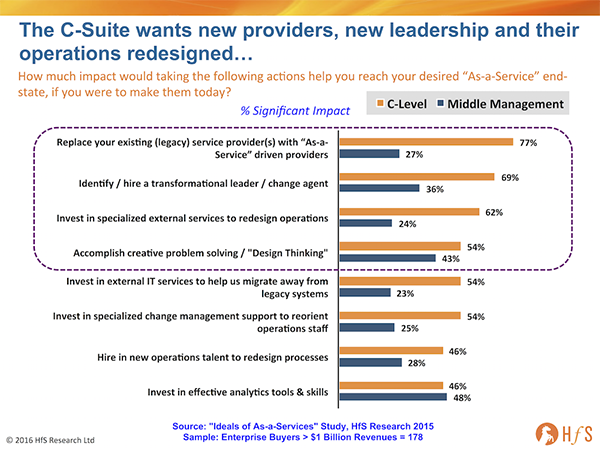There is a staggering gap between C-level executives and middle managers when it comes to dealing with the change digital-enabled business models and new services paradigms force upon us. The journey to the As-a-Service Economy is met with enthusiasm by the C-Suite (see Exhibit 1). But their middle management has a different take: shying away from big transformational initiatives and focusing on more tactical interventions. Are you all living in the same world?

We should not blame middle management for the inertia we witness in many industries, including the business and IT services industry.
Anxiety and resistance are logical reactions to change. People don’t like change, as it threatens the status quo, what they know and worked hard for. This is the playground of the sunk cost fallacy. “We worked so hard to get to where we are: we can’t throw that away. We need to keep going to maintain what we have”. C-Suite respondents in our large surveys show they’re not willing to throw good money at keeping the status quo. That is the big point: change is inevitable. The way a company deals with change will increasingly be a deciding factor for survival and competitive advantage.
The Ball is in the C-Suite’s Court
Having a vision is one thing, enabling implementation and executing the vision is significantly different. Middle management’s lukewarm reaction to change is understandable and frankly not surprising. There is a lot of uncertainty about new technologies such as autonomics, robotic process automation, artificial intelligence, and cognitive computing. There are wild predictions about robots destroying people’s jobs. People are wondering how they will be impacted; what do the changes mean, what will my job look like in this As-a-Service economy, do I have the skills to be successful?
Uncertainty is the enemy of the ability to embrace change.
The answer? Educate, show results and impact. Also, are people incentivized in the right way to lead sweeping change? Or are they incentivized to drive incremental improvement? Aligning incentives to the ultimate goal is paramount.
“Beam me up, Scotty”
Wouldn’t we all want to just be there, at the destination? Counting the times, you would love to say, “Beam me up, Scotty” … But alas, if you need to go somewhere, you must endure the journey.
It is a journey to change, and all road warriors know making a journey is not always fun, it is pretty exhausting, and you often have to deal with unpleasant adversity.
Investing in disruptive technologies is one thing. Successfully implementing them and going through the change process as a business is another. C-Suite respondents are likely to bring in external help in the form of transformational leadership or change agents to redesign the operations. However, to be successful, they need to inspire, motivate, and properly measure and provide associated incentives and rewards for the team.
Often when a sports team is dysfunctional, the leadership tries to shake things up by firing the coach and bringing in new blood. On the one hand, a new perspective can change the dynamics of the team for the better. On the contrary, there is an entirely pragmatic reason to fire coaches; it is much easier and cheaper to fire one coach than to fire all players. This logic holds true for enterprises as well. An external stimulus is good, but getting rid of the middle management is impossible and threatens the going concern (aka the revenue generating machine). See here the dilemma for the large incumbent with legacy operations trying to fight off the nimble new entrants, who simply don’t have to drag all the baggage with them.
A Plan is as Good as its Implementation
Leadership is critical; don’t let there be any doubt about the destination, the Northern Star. But, involve the rest of the company to map out the journey. Let them be a part of the solution. Our research shows the gap between C-Suite and middle management is significantly smaller when asked about using creative problem solving (Design Thinking) to reach the As-a-Service end-state. 54% of C-Suite and 43% of middle management think Design Thinking will have a significant impact on the journey.
Unleash the Knowledge and Creativity of the Company
Years of operational excellence, Lean and Six Sigma have beaten all creativity out of operations and middle management. You get what you pay for. So if you pay for hundreds of green KPI’s, you get hundreds of micro-managed green KPI’s.
C-level leadership has to set creativity free, unleash the innovative power of the workforce. Granted, corporate Japan is not the prime example of free-spirited creativity, but they have a thorough understanding of the power of expert knowledge. Toyota’s concept of the Creative Idea Suggestion System brought them a lot of good (and paradoxically they copied it from the American firms they tried to beat). For service providers, a big challenge will be to integrate the innovation labs and all the beauty created there into the legacy beast. Innovation labs can quickly become ivory towers. And no-one likes the people shouting from ivory towers.
Revamp Imagination by Creating a Culture Capable of Dealing with Constant Change
Our take on change? Use the old concepts of Total Participation and Employee Engagement and focus it on creative, lateral problem solving and Design Thinking (instead of operational excellence and Lean Six Sigma) in an era of increasing volatility, uncertainty and technology driven change. Bring in academics, analysts, practitioners, other ‘thinkers’, but most of all the company’s own brain trust.
We are not arguing everyone will be a good fit in the new era, or that the goal is to keep everybody on board and happy. But an inclusive strategy to alter the culture is ultimately the most promising trajectory for change.
Our subscribers can download our upcoming Blueprint Report on Design Thinking in a few days here in our ever-growing research library.
Posted in : Design Thinking






